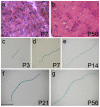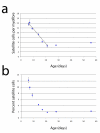Dynamics of muscle fibre growth during postnatal mouse development
- PMID: 20175910
- PMCID: PMC2836990
- DOI: 10.1186/1471-213X-10-21
Dynamics of muscle fibre growth during postnatal mouse development
Abstract
Background: Postnatal growth in mouse is rapid, with total skeletal muscle mass increasing several-fold in the first few weeks. Muscle growth can be achieved by either an increase in muscle fibre number or an increase in the size of individual myofibres, or a combination of both. Where myofibre hypertrophy during growth requires the addition of new myonuclei, these are supplied by muscle satellite cells, the resident stem cells of skeletal muscle.
Results: Here, we report on the dynamics of postnatal myofibre growth in the mouse extensor digitorum longus (EDL) muscle, which is essentially composed of fast type II fibres in adult. We found that there was no net gain in myofibre number in the EDL between P7 and P56 (adulthood). However, myofibre cross-sectional area increased by 7.6-fold, and length by 1.9-fold between these ages, resulting in an increase in total myofibre volume of 14.1-fold: showing the extent of myofibre hypertrophy during the postnatal period. To determine how the number of myonuclei changes during this period of intense muscle fibre hypertrophy, we used two complementary mouse models: 3F-nlacZ-E mice express nlacZ only in myonuclei, while Myf5nlacZ/+ mice have beta-galactosidase activity in satellite cells. There was a approximately 5-fold increase in myonuclear number per myofibre between P3 and P21. Thus myofibre hypertrophy is initially accompanied by a significant addition of myonuclei. Despite this, the estimated myonuclear domain still doubled between P7 and P21 to 9.2 x 103 microm3. There was no further addition of myonuclei from P21, but myofibre volume continued to increase, resulting in an estimated approximately 3-fold expansion of the myonuclear domain to 26.5 x 103 microm3 by P56. We also used our two mouse models to determine the number of satellite cells per myofibre during postnatal growth. Satellite cell number in EDL was initially approximately 14 satellite cells per myofibre at P7, but then fell to reach the adult level of approximately 5 by P21.
Conclusions: Postnatal fast muscle fibre type growth is divided into distinct phases in mouse EDL: myofibre hypertrophy is initially supported by a rapid increase in the number of myonuclei, but nuclear addition stops around P21. Since the significant myofibre hypertrophy from P21 to adulthood occurs without the net addition of new myonuclei, a considerable expansion of the myonuclear domain results. Satellite cell numbers are initially stable, but then decrease to reach the adult level by P21. Thus the adult number of both myonuclei and satellite cells is already established by three weeks of postnatal growth in mouse.
Figures




Similar articles
-
The effect of resistance training, detraining and retraining on muscle strength and power, myofibre size, satellite cells and myonuclei in older men.Exp Gerontol. 2020 May;133:110860. doi: 10.1016/j.exger.2020.110860. Epub 2020 Feb 1. Exp Gerontol. 2020. PMID: 32017951
-
Myostatin inhibition induces muscle fibre hypertrophy prior to satellite cell activation.J Physiol. 2012 May 1;590(9):2151-65. doi: 10.1113/jphysiol.2011.226001. Epub 2012 Mar 5. J Physiol. 2012. PMID: 22393251 Free PMC article.
-
Epigenetic evidence for distinct contributions of resident and acquired myonuclei during long-term exercise adaptation using timed in vivo myonuclear labeling.Am J Physiol Cell Physiol. 2022 Jan 1;322(1):C86-C93. doi: 10.1152/ajpcell.00358.2021. Epub 2021 Nov 24. Am J Physiol Cell Physiol. 2022. PMID: 34817266 Free PMC article.
-
Muscle Fiber Hypertrophy and Myonuclei Addition: A Systematic Review and Meta-analysis.Med Sci Sports Exerc. 2018 Jul;50(7):1385-1393. doi: 10.1249/MSS.0000000000001593. Med Sci Sports Exerc. 2018. PMID: 29509639
-
Role of satellite cells in muscle growth and maintenance of muscle mass.Nutr Metab Cardiovasc Dis. 2013 Dec;23 Suppl 1:S12-8. doi: 10.1016/j.numecd.2012.02.002. Epub 2012 May 22. Nutr Metab Cardiovasc Dis. 2013. PMID: 22621743 Review.
Cited by
-
Muscle Satellite Cell Protein Teneurin-4 Regulates Differentiation During Muscle Regeneration.Stem Cells. 2015 Oct;33(10):3017-27. doi: 10.1002/stem.2058. Epub 2015 Jun 28. Stem Cells. 2015. PMID: 26013034 Free PMC article.
-
Reduced Notch signalling leads to postnatal skeletal muscle hypertrophy in Pofut1cax/cax mice.Open Biol. 2016 Sep;6(9):160211. doi: 10.1098/rsob.160211. Open Biol. 2016. PMID: 27628322 Free PMC article.
-
Reply from Elizabeth Schroder, Brian Hodge, Lance Riley, Xiping Zhang and Karyn Esser.J Physiol. 2016 Jun 1;594(11):3163-4. doi: 10.1113/JP272165. J Physiol. 2016. PMID: 27246552 Free PMC article. No abstract available.
-
Exposure of C57BL/6J mice to long photoperiod during early life stages increases body weight and alters plasma metabolomic profiles in adulthood.Physiol Rep. 2016 Sep;4(18):e12974. doi: 10.14814/phy2.12974. Physiol Rep. 2016. PMID: 27650252 Free PMC article.
-
An intronic SNP affects skeletal muscle development by regulating the expression of TP63.Front Vet Sci. 2024 Jun 12;11:1396766. doi: 10.3389/fvets.2024.1396766. eCollection 2024. Front Vet Sci. 2024. PMID: 38933706 Free PMC article.
References
-
- Ross JJ, Duxson MJ, Harris AJ. Formation of primary and secondary myotubes in rat lumbrical muscles. Development. 1987;100:383–94. - PubMed
Publication types
MeSH terms
Grants and funding
LinkOut - more resources
Full Text Sources
Other Literature Sources
Research Materials

